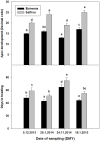Relationship Between Dehydrin Accumulation and Winter Survival in Winter Wheat and Barley Grown in the Field
- PMID: 30761163
- PMCID: PMC6361858
- DOI: 10.3389/fpls.2019.00007
Relationship Between Dehydrin Accumulation and Winter Survival in Winter Wheat and Barley Grown in the Field
Abstract
Low temperatures represent a crucial environmental factor determining winter survival (WS) of barley and wheat winter-type varieties. In laboratory experiments, low temperatures induce an active plant acclimation response, which is associated with an enhanced accumulation of several stress-inducible proteins including dehydrins. Here, dehydrin accumulations in sampled wheat (WCS120 protein family, or WCS120 and WDHN13 transcripts) and barley (DHN5 protein) varieties grown in two locations for two winters were compared with the variety WS evaluated by a provocation wooden-box test. A high correlation between dehydrin transcripts or protein relative accumulation and variety WS score was found only in samples taken prior vernalization fulfillment, when high tolerant varieties accumulated dehydrins earlier and to higher level than less tolerant varieties, and the plants have not yet been vernalized. After vernalization fulfillment, the correlation was weak, and the apical development indicated that plants reached double ridge (DR) in barley or stayed before DR in wheat. Dehydrin proteins and transcripts can be thus used as reliable markers of wheat or barley variety winter hardiness in the field conditions; however, only at the beginning of winter, when the plants have not yet finished vernalization. In wheat, a higher correlation was obtained for the total amount of dehydrins than for the individual dehydrin proteins.
Highlights: -More tolerant winter-type wheat and barley plants reveal higher threshold induction temperatures for dehydrin accumulation in comparison to less tolerant varieties. Thus, more tolerant winter cereals have higher dehydrin levels than the less tolerant ones upon the same ambient temperature in November samplings.-A significant correlation between dehydrin transcript/protein accumulation and winter survival was found in both winter wheat and winter barley plants in the field conditions, but only prior to vernalization fulfillment.
Keywords: apical development; dehydrins; field trials; vernalization; winter barley; winter survival; winter wheat.
Figures





References
-
- Crosatti C., Mare C., Mazzucotelli E., Selioni S., Barilli S., Bassi R., et al. (2003). Genetic analysis of the expression of the cold-regulated gene cor14b: a way toward the identification of components of the cold response signal transduction in Triticeae. Can. J. Bot. 81 1162–1167. 10.1139/B03-114 - DOI
-
- Crosatti C., Pagani D., Cattivelli L., Stanca A. M., Rizza F. (2008). Effects of growth stage and hardening conditions on the association between frost resistance and the expression of the cold-induced protein COR14b in barley. Environ. Exp. Bot. 62 93–100. 10.1016/j.envexpbot.2007.07.008 - DOI
LinkOut - more resources
Full Text Sources

